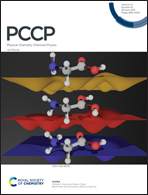The freezing behavior of aqueous n-alcohol nanodroplets†
Abstract
We generate water-rich aerosols containing 1-propanol and 1-pentanol in a supersonic nozzle to study the effects of these solutes on the freezing behavior of water. Condensation and freezing are characterized by two complementary techniques, pressure trace measurements and Fourier Transform Infrared spectroscopy. When 1-pentanol and 1-propanol are present, condensation occurs at higher temperatures because particle formation from the vapor phase is enhanced by the decrease in interfacial free energy of mixed aqueous-alcohol critical clusters relative to those of pure water. FTIR results suggest that when ∼6 nm radius droplets freeze, the tetrahedral structure of the ice is well preserved up to an overall alcohol mole fraction of 0.031 for 1-propanol and 0.043 for 1-pentanol. In this concentration range, the ice nucleation temperature decreases continuously with increasing 1-propanol concentration, whereas the onset of freezing is not significantly perturbed by 1-pentanol up to a mole fraction of 0.03. Furthermore, once freezing starts the ice nucleation rates in the aqueous-alcohol droplets are very close to those for pure water. In contrast, at the highest mole fractions of either alcohol it is not clear whether droplets freeze to form crystalline ice since the final state of the particles cannot be adequately characterized with the available experimental techniques.



 Please wait while we load your content...
Please wait while we load your content...
